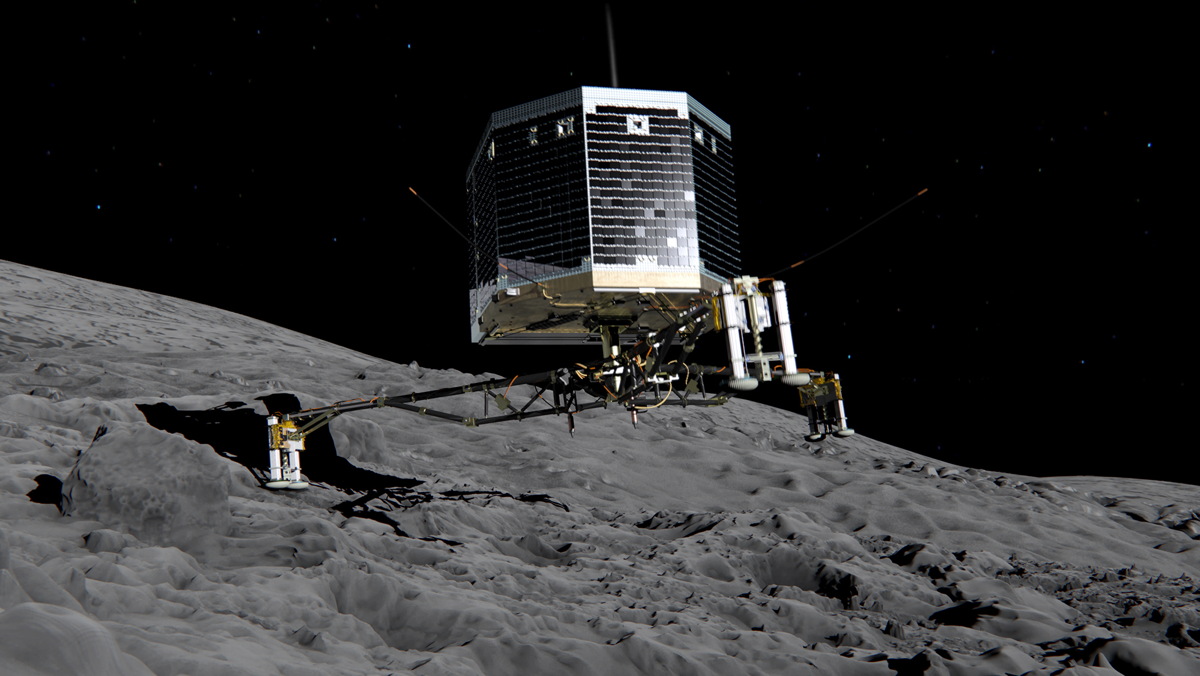European Probe to Make Daring Landing on Comet Wednesday: Watch Live

A European probe is expected to make an audacious landing on the face of a comet tomorrow (Nov. 12), and you can follow it live online starting today (Nov. 11).
The European Space Agency's Rosetta spacecraft is currently orbiting Comet 67P/Churyumov-Gerasimenko while speeding through deep space. If successful, the landing will mark the first time humans have soft-landed a probe on a comet. Rosetta is due to release the Philae lander down to the comet's surface on Wednesday, and three different space-focused organizations will host Rosetta webcasts tonight and into tomorrow. You can watch the Philae landing webcasts live on Space.com.
European Space Agency officials will keep the public updated about the progress of the Philae landing during a broadcast that begins at 2 p.m. EST (1900 GMT) today. Scientists should know if the landing was successful by about 11:00 a.m. EST (1600 GMT) on Nov. 12. Officials will share updates about Rosetta and Philae during the webcast, which will broadcast live for about 24 hours. [See images from the Rosetta mission]
NASA will also host a webcast about Philae's landing, on Nov. 12, and the online Slooh Community Observatory will show live views of Comet 67P/C-G during the observatory's webcast after the landing, also on Nov. 12. You can watch the Slooh webcast directly (http://live.slooh.com/), as well.
Rosetta will release Philae down to the comet's surface when the two spacecraft are flying about 14 miles (22.5 kilometers) from the "dirty snowball's" face at about 3:35 a.m. EST (0835 GMT). Scientists will find out if the separation of the two spacecraft was successful about 28 minutes and 20 seconds later, once Rosetta's signal reaches Earth. Mission controllers on the ground have picked out what seems to be a relatively smooth landing zone (called "Agilkia") on the craggy comet's face.
Once released, Philae will have no ability to maneuver itself midair, but ESA officials should get an update about the comet's progress down to the surface at about 5:53 a.m. EST (1053 GMT), when Rosetta should establish contact with the lander on its way down. Philae's mothership, still orbiting the comet, will then be able to transmit science data and other information about Philae's health to people on Earth.
Scientists working with Philae hope that the lander's trajectory will take it to an easy touchdown, but this might involve a little luck, according to mission managers.
Get the Space.com Newsletter
Breaking space news, the latest updates on rocket launches, skywatching events and more!
"The surface of this comet is very, very rough," Andrea Accomazzo, ESA Rosetta flight director, said during the webcast. "It's not the ideal place to land on, but this is what we have, and this is what we're trying to do. We have to be a bit lucky, as well. If the lander hits the surface of the comet in the proximity of a boulder or something like this, then there's nothing we can do."
After touchdown, Philae will deploy a harpoon that will keep it in place in Comet 67P/C-G's low gravity. ESA officials will use Philae to take measurements and snap photos on the comet. This will help gather more information about this mysterious type of cosmic body, a leftover from the dawn of the solar system.
Rosetta and Philae launched to space in 2004. They flew about 4 billion miles through space before arriving at Comet 67P/C-G in August. The Rosetta mission is expected to continue at least through December 2015.
You can find a full schedule of webcast events from ESA here: http://www.esa.int/esatv/Television
Follow Miriam Kramer @mirikramer and Google+. Follow us @Spacedotcom, Facebook and Google+. Original article on Space.com.
Join our Space Forums to keep talking space on the latest missions, night sky and more! And if you have a news tip, correction or comment, let us know at: community@space.com.

Miriam Kramer joined Space.com as a Staff Writer in December 2012. Since then, she has floated in weightlessness on a zero-gravity flight, felt the pull of 4-Gs in a trainer aircraft and watched rockets soar into space from Florida and Virginia. She also served as Space.com's lead space entertainment reporter, and enjoys all aspects of space news, astronomy and commercial spaceflight. Miriam has also presented space stories during live interviews with Fox News and other TV and radio outlets. She originally hails from Knoxville, Tennessee where she and her family would take trips to dark spots on the outskirts of town to watch meteor showers every year. She loves to travel and one day hopes to see the northern lights in person. Miriam is currently a space reporter with Axios, writing the Axios Space newsletter. You can follow Miriam on Twitter.









